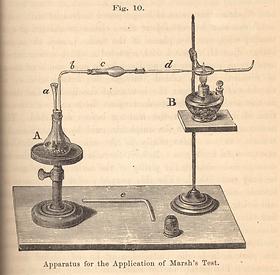Cases
Toxicology on trial: Mathieu Orfila and the Lafarge murder case
In France, in 1840, a notorious murder trial put the young science of toxicology to a dramatic test. Rumored to be unhappy in her marriage, Marie Lafarge, age 24, was charged with poisoning her husband Charles. Witnesses had seen her buying arsenic—to exterminate rats, she claimed—and testified that she had stirred a white powder into her husband's food. The prosecution sought to build on this by introducing the findings of local doctors who performed chemical tests on Charles Lafarge's stomach and on the white powders that had been gathered as evidence.
But Mme. Lafarge's lawyer strongly challenged the scientific methods and competence of the prosecution's medical witnesses, who were unacquainted with the improved test for arsenic which James Marsh, an English chemist, had devised four years earlier. As lawyers on both sides cross-examined the doctors, increasing doubt was cast on their methods and results. The judge ordered Charles Lafarge's body to be exhumed, and more tests to be performed by the doctors. These showed no evidence of arsenic—a result which, in turn, was contradicted by a new chemical analysis of food which Mme. Lafarge had prepared for her husband. As all of this played out in the courtroom, newspaper reporters provided a stream of stories: the Lafarge case became a media sensation.
In the end, both sides agreed to consult the highest authority, Mathieu Orfila, the eminent professor of forensic medicine, and the world's greatest expert on toxicology, who was summoned from Paris. Orfila conducted Marsh tests on samples taken from Charles Lafarge's body and the soil around the burial site. He found definite traces of arsenic in the body, and showed that it did not come from the surrounding soil. The defense's last gasp was to summon yet another expert witness, François Raspail, Orfila's bitter enemy, who had already jousted with him in a previous case.
Raspail arrived too late: the verdict had already been given. Mme. Lafarge was found guilty of murder, and received a death sentence, which was later commuted to life in prison. But the controversy continued. Although Orfila's performance of the Marsh test for arsenic was publicly celebrated as a vindication of forensic science, Raspail and his allies charged that Orfila's analysis was also flawed, and that Marie Lafarge was innocent.
